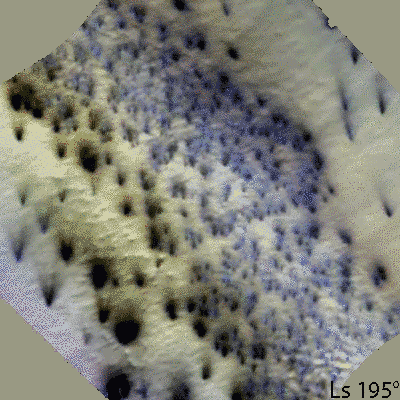Emily Lakdawalla • May 13, 2010
Happy solstice -- on Mars
EDIT 9:30 p.m.: Confirmed that they are doing one last Phoenix listening campaign now that the solstice has arrived.
It's the solstice on Mars today: summer in the north, winter in the south. The Sun's done marching northward in the sky, bathing the northern hemisphere in its longest sunlit day of the year, appearing low on the horizon (or not at all) in the southern hemisphere.
It's most significant for two silent Mars missions. Spirit is, we all hope, hanging out in hibernation at Gusev crater, waiting patiently for the solar cells to catch enough rays to charge her batteries back up enough to power her radio transmitter to call home. She was last heard from on sol 2,218 (March 30); it's now sol 2,268. So I really don't expect to hear from her before sol 2,318 (July 11), and likely later, because Spirit was running on borrowed power in those final days, and who knows how much more dust she may have on her solar panels now. Or not. Maybe she got lucky and got cleaned off again, and we'll hear from her sooner.
This will also be the day that the Phoenix lander will be bathed in the most sunlight at the highest angle above the horizon. Many attempts have been made to contact Phoenix, with no answer. There was some discussion that one last effort would be made right around solstice They announced today that they're conducting one last listening campaign, while a still-functioning Phoenix would have the best possible chance at generating power. I don't think anyone really expects to hear from her -- but I can tell you that if we don't hear from her now, it's pretty certain that contact will never be made.
Although the orbiters don't feel any changes from the shifting of the seasons (as far as I know), it's still a significant date for orbital missions. From this day forward, there'll be lots of observations of the twilit areas near the Martian south pole, which will now be starting to receive sunlight for the first time after their winter period of darkness. During the dark days, carbon dioxide condensed as winter frost; we'll see that frost, and we'll see the cool features it forms when it defrosts. And, to mention one more silent Martian lander, the search can continue again for the missing Mars Polar Lander.

Support our core enterprises
Your support powers our mission to explore worlds, find life, and defend Earth. You make all the difference when you make a gift. Give today!
Donate

 Explore Worlds
Explore Worlds Find Life
Find Life Defend Earth
Defend Earth

